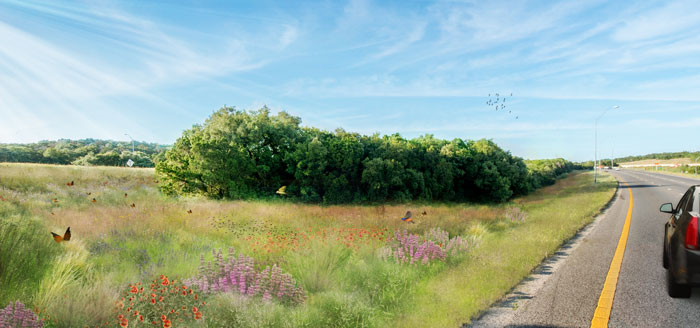Texas Roadsides Deserve Better

Lady Bird Johnson stands in a field of wildflowers alongside a Texas state highway. The first lady inspired the Highway Beautification Act of 1965, which celebrates its 50th anniversary this October. Doing so set in motion a number of roadside-related initiatives that endure to this day. PHOTO Wildflower Center Archives
THE HIGHWAY BEAUTIFICATION ACT was signed by President Lyndon B. Johnson 50 years ago this October. It was a bold move against a powerful advertising industry to reduce the visual impact of billboards and junkyards alongside the country’s federal highway system. The bill also catalyzed decades of work to improve the ecology of roadsides. Transportation departments around the country have been both friend and foe to that movement along the way.
Lady Bird Johnson was the act’s true champion, and for her, it was not just about resolving the degradation of the visual experience of an extensive roadway system, but an opportunity to bring to our roads ecological richness, regional identity and a reminder of our personal connection to nature.
The highway beautification movement was meant to drive us back to nature. But the truth is, 50 years on, there is still so much work to be done.
The success of the bill, and Mrs. Johnson’s efforts when she returned to Texas, has given us the captivating wildflower displays that we now expect as part of the spring highway experience. Indeed, there are many roadsides around the country where you can find prairie remnants and gorgeous plantings that feature native grasses and wildflowers. Texans in particular take great pride in their roadside shoulders with jaw-dropping displays of native wildflowers amidst swathes of prairie grasses.
Sadly, these colorful displays are often the exception not the rule.
Large stretches of our roadsides are colonized by grass and weed species originating from around the globe. Non-native grasses such as Old World bluestems from Asia, buffelgrass from Africa, and perennial ryegrass from Europe can easily out-compete and replace our native prairie vegetation. In fact, many of these offending species are, or were, in highway department plant lists and have been planted for their ability to colonize quickly to fulfill the vegetative cover required by engineering specifications. Some other weedy culprits, like the bastard cabbage from the Mediterranean that covers miles and miles of roadsides in swathes of bright yellow in spring, are even considered by many to be native to Texas.
You can see evidence of this when you drive between the cities of the Texas Triangle – Houston, San Antonio, Austin, Dallas and Fort Worth – where there is no shortage of roadway construction. Both construction areas and finished roadsides are overgrown with invasive plants and an assortment of non-native weeds. These plants make the landscapes we drive through look like anyplace U.S.A.
This is a missed opportunity. By applying ecological design consciously to roadsides, we could be driving through uniquely picturesque and ecologically important native ecosystems.
Nationally, roadsides cover some 17 million acres. By way of comparison, all the National Parks in the contiguous U.S. make up 27 million acres. Studies have shown that ecologically-designed and managed roadsides can clean water, reduce noise, improve air quality, sequester carbon, conserve native plant species and provide habitat for declining and charismatic species like the monarch butterfly. A joint report released earlier this year from the Federal Highway Administration and the Xerces Society suggests that roadsides can significantly contribute to the provision of habitat to honey and native bees that are essential for $18 billion of crop production.
This is an open opportunity for our state and county roadside authorities because we can get all the benefits of an ecological roadside. How? By first deciding to do roadsides right. Unfortunately, it isn’t a question of just sowing native seeds – that’s the easy part. Invasive species must be managed throughout the construction process, soils need to be stockpiled and modified to provide an un-compacted, healthy substrate, and mow and no-mow management protocols must be used appropriately to foster the landscape. And perhaps most importantly, contractors hired to do the work must be held accountable for both biological and engineering specifications.
“Lady Bird’s Bill” created a game-changing legacy for the American landscape. Let’s respect and reinforce it by encouraging and demanding more for our roadsides. There is nothing to lose and everything to gain in the next 50 years.
Mark Simmons, Ph.D. (1960-2015) was director of research and consulting at the Lady Bird Johnson Wildflower Center.
A version of this op-ed appeared in the Fall 2015 issue of Wildflower magazine.

